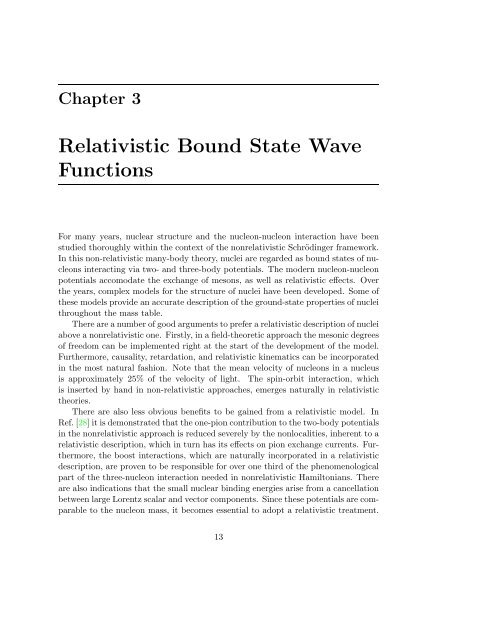Download Thesis in Pdf Format - Theoretical Nuclear Physics and ...
Download Thesis in Pdf Format - Theoretical Nuclear Physics and ...
Download Thesis in Pdf Format - Theoretical Nuclear Physics and ...
You also want an ePaper? Increase the reach of your titles
YUMPU automatically turns print PDFs into web optimized ePapers that Google loves.
Chapter 3<br />
Relativistic Bound State Wave<br />
Functions<br />
For many years, nuclear structure <strong>and</strong> the nucleon-nucleon <strong>in</strong>teraction have been<br />
studied thoroughly with<strong>in</strong> the context of the nonrelativistic Schröd<strong>in</strong>ger framework.<br />
In this non-relativistic many-body theory, nuclei are regarded as bound states of nucleons<br />
<strong>in</strong>teract<strong>in</strong>g via two- <strong>and</strong> three-body potentials. The modern nucleon-nucleon<br />
potentials accomodate the exchange of mesons, as well as relativistic effects. Over<br />
the years, complex models for the structure of nuclei have been developed. Some of<br />
these models provide an accurate description of the ground-state properties of nuclei<br />
throughout the mass table.<br />
There are a number of good arguments to prefer a relativistic description of nuclei<br />
above a nonrelativistic one. Firstly, <strong>in</strong> a field-theoretic approach the mesonic degrees<br />
of freedom can be implemented right at the start of the development of the model.<br />
Furthermore, causality, retardation, <strong>and</strong> relativistic k<strong>in</strong>ematics can be <strong>in</strong>corporated<br />
<strong>in</strong> the most natural fashion. Note that the mean velocity of nucleons <strong>in</strong> a nucleus<br />
is approximately 25% of the velocity of light. The sp<strong>in</strong>-orbit <strong>in</strong>teraction, which<br />
is <strong>in</strong>serted by h<strong>and</strong> <strong>in</strong> non-relativistic approaches, emerges naturally <strong>in</strong> relativistic<br />
theories.<br />
There are also less obvious benefits to be ga<strong>in</strong>ed from a relativistic model. In<br />
Ref. [28] it is demonstrated that the one-pion contribution to the two-body potentials<br />
<strong>in</strong> the nonrelativistic approach is reduced severely by the nonlocalities, <strong>in</strong>herent to a<br />
relativistic description, which <strong>in</strong> turn has its effects on pion exchange currents. Furthermore,<br />
the boost <strong>in</strong>teractions, which are naturally <strong>in</strong>corporated <strong>in</strong> a relativistic<br />
description, are proven to be responsible for over one third of the phenomenological<br />
part of the three-nucleon <strong>in</strong>teraction needed <strong>in</strong> nonrelativistic Hamiltonians. There<br />
are also <strong>in</strong>dications that the small nuclear b<strong>in</strong>d<strong>in</strong>g energies arise from a cancellation<br />
between large Lorentz scalar <strong>and</strong> vector components. S<strong>in</strong>ce these potentials are comparable<br />
to the nucleon mass, it becomes essential to adopt a relativistic treatment.<br />
13















